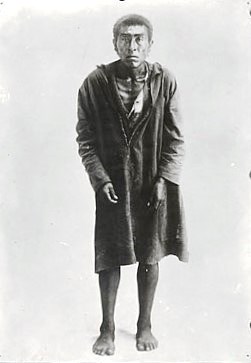Ishi,
the Last Yahi Indian Speaker (center),
at an Unveiling of an Indian Monument,
Lincoln
Park, Alameda, California, 1914
California Historical Society
In the early part of the twentieth century—following the near
annihilation of California’s Native Americans the century before—a singular
event occurred. In many ways, Natives and non-Natives still experience the
impact of this event on communities across the state.
In the summer of 1911, at a slaughterhouse corral near the town of
Oroville in northern California’s Butte County, a middle-aged man—most likely
of the Yahi tribe native to the Deer Creek region—was discovered in a state of
exhaustion and emaciation. The sole survivor of a small band of Indians thought
to have been extinguished during the California Indian Wars, he had come out of
isolation in the mountains.
Ishi at Time of
His Capture, Oroville, Butte County, September 1911
Published in Popular Science Monthly (March 1915)
Courtesy of Phoebe A. Hearst Museum of Anthropology, UC
Berkeley
Bruce A. Hardy (Photographer), View of
“Ishi Site,” Oroville, CA, 1963
Courtesy of Phoebe A. Hearst Museum of
Anthropology, UC Berkeley
This “unprecedented behavior,” Theodora Kroeber
observed in her book Ishi in Two Worlds:
A Biography of the Last Wild Indian in North America (1916), had resulted from crossing “certain physical and psychic limits” from
which Ishi—as he
was simply called, from the Yahi word for man—“made choices
as courageous and enlightened as the scope of his opportunities permitted.”
Kroeber was
the wife of the famous anthropologist Alfred L. Kroeber, under whose care, along
with that of Thomas T. Waterman, Ishi was
placed. Ishi would live the remainder of his life adapting
to the twentieth century at the University of California’s Museum of Anthropology in San Francisco. There he was closely studied for five years until
his death in March 1916.
Courtesy of Phoebe A. Hearst Museum of Anthropology, UC
Berkeley
To the museum’s anthropologists, staff, and visitors, Ishi imparted his
language, survival and crafts skills, culture, and personal beliefs. To them—and to us even today—his life brought new understandings of
Native American heritage in the context of and in contrast to twentieth-century
urban life.
Ishi Salmon
Fishing on Deer Creek, May 1914
Courtesy of Bancroft Library, UC Berkeley
Native and
non-Native scholars, artists, cultural and educational leaders, and community
members continue to explore these understandings. At the California Historical Society,
for example:
- · In conjunction with our year-long 2015 exhibition celebrating the 1915 San Francisco World’s Fair, the projected light artist Ben Wood examined Ishi’s life within the context of the fair, which Ishi attended. Wood’s piece Lopa Pikta (Rope Picture), a sound and light installation, was displayed in the windows of the California Historical Society after dark. See http://www.californiahistoricalsociety.org/exhibitions/past_exhibitions/illumination/.
Ben Wood, Lopa Pikta (Rope Picture), 2015
California Historical
Society
- · Beginning this July CHS offers two Native American exhibitions. One examines the impact of California’s only major Indian War (the Modoc War of 1872–73). The other features contemporary tintype portraits by photographer Ed Drew of members of the Klamath, Modoc, and Pit River Paiute tribes, some of them descendants of Modoc War survivors. See http://www.californiahistoricalsociety.org/exhibitions/current_exhibitions.
- · This month in Los Angeles, and this October in San Francisco, CHS invites author Benjamin Madley to speak about his newly published book An American Genocide: The United States and the California Indian Catastrophe, 1846–1873. As the New York Times began its review, “The state of sunshine and pleasure is drenched in the blood of Indians.” See http://www.californiahistoricalsociety.org/exhibitions/events_calendar.html.
Benjamin Madley Discussing His Book (right) at Skylight Book in Los Angeles,
May 2016
Courtesy
of Shelly Kale
Shelly Kale
Publications
and Strategic Projects Manager
skale@calhist.org
Sources
- William Bauer, “Stop Hunting Ishi,” Boom: A Journal of California 4, no. 3 (Fall 2014); http://www.boomcalifornia.com/2014/09/stop-hunting-ishi
- Theodora Kroebler, Ishi in Two Worlds: A Biography of the Last Wild Indian in North America (Berkeley: University of California Press, 1961)
- Benjamin Madley, “It’s time to acknowledge the genocide of California’s Indians,” Los Angeles Times, May 22, 2016; http://www.latimes.com/opinion/op-ed/la-oe-madley-california-genocide-20160522-snap-story.html
- Carl Nolte, “Ishi, last of his tribe, bridges 2 worlds in film every night,” San Francisco Chronicle, Aug. 29, 2015; http://www.sfchronicle.com/bayarea/nativeson/article/Ishi-last-of-his-tribe-bridges-2-worlds-in-film-6473649.php
- Alan Taylor, “‘An American Genocide’ by Benjamin Madley,” New York Times, May 27, 2016; http://www.nytimes.com/2016/05/29/books/review/an-american-genocide-by-benja.html?_r=0










No comments:
Post a Comment